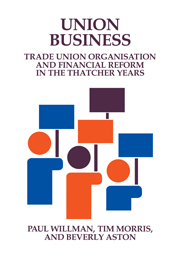Book contents
- Frontmatter
- Contents
- Acknowledgements
- 1 Introduction: unions in the 1980s
- 2 The financial status of British trade unions 1950–1989
- 3 Financial differences between unions
- 4 The role of financial matters in union organisation
- 5 The politics of union finaces
- 6 Union size, growth, and financial performance
- 7 Strike activity and union finances
- 8 The National Union of Mineworkers: strikes and financial disaster
- 9 The GMB: merger and financial reform
- 10 The Amalgamated Engineering Union: back from the brink
- 11 The Banking, Insurance and Finance Union: competitive unionism and financial survival
- 12 The Electrical, Electronic, Telecommunications and Plumbing Trade Union: accountability and financial control
- 13 Conclusions: union business and business unionism
- Appendix 1 Research methods
- Appendix 2 Regression results
- Appendix 3 Questions for finance officers
- Appendix 4 Questions for General Secretaries
- Appendix 5 Questionnaire: trade union finances
- Appendix 6 The number of trade unions
- Notes
- References
- Subject index
- Index of trade unions
- Author index
11 - The Banking, Insurance and Finance Union: competitive unionism and financial survival
Published online by Cambridge University Press: 11 March 2010
- Frontmatter
- Contents
- Acknowledgements
- 1 Introduction: unions in the 1980s
- 2 The financial status of British trade unions 1950–1989
- 3 Financial differences between unions
- 4 The role of financial matters in union organisation
- 5 The politics of union finaces
- 6 Union size, growth, and financial performance
- 7 Strike activity and union finances
- 8 The National Union of Mineworkers: strikes and financial disaster
- 9 The GMB: merger and financial reform
- 10 The Amalgamated Engineering Union: back from the brink
- 11 The Banking, Insurance and Finance Union: competitive unionism and financial survival
- 12 The Electrical, Electronic, Telecommunications and Plumbing Trade Union: accountability and financial control
- 13 Conclusions: union business and business unionism
- Appendix 1 Research methods
- Appendix 2 Regression results
- Appendix 3 Questions for finance officers
- Appendix 4 Questions for General Secretaries
- Appendix 5 Questionnaire: trade union finances
- Appendix 6 The number of trade unions
- Notes
- References
- Subject index
- Index of trade unions
- Author index
Summary
Historical background
BIFU's current strategy and financial position can only be understood in the context of the union's long fight for recognition against employer hostility. Founded at the end of the First World War as an all-grades union for clerks in the English clearing banks, it grew very quickly and by 1920–1 could claim 10,000 members. Subsequently, this growth ceased as the banks indicated their disinterest in or outright opposition to trade unionism. In most cases, they set up rival staff associations. There then followed a long period during which the union unsuccessfully sought recognition in each of the banks. Eventually, recognition was achieved in Barclays Bank. During this time the union's membership stagnated and it struggled financially.
The banks' staff associations benefited from employer subsidy and did not need complex bargaining arrangements, hence their overheads were extremely low: in most cases they did not charge a subscription until after the Second World War. This forced the national union's operations to remain small and centralised. Nevertheless, it remained union policy that all officials had to be employed full time by the union to ensure their independence, in contrast to the situation in the company-based staff associations.
This preoccupation with independence as the means to differentiate itself from its competitors also influenced the union's structure. Branches were organised geographically rather than on a company basis and the union tried to stress the importance of industry-wide, rather than of domestic company, issues. Such a focus proved difficult to sustain.
- Type
- Chapter
- Information
- Union BusinessTrade Union Organisation and Financial Reform in the Thatcher Years, pp. 170 - 184Publisher: Cambridge University PressPrint publication year: 1993



